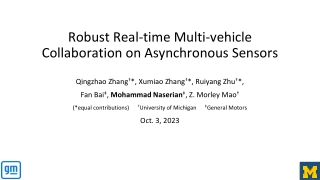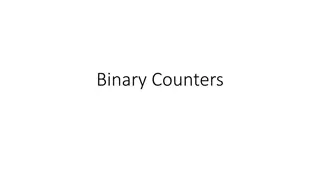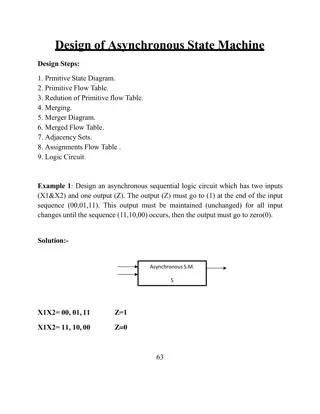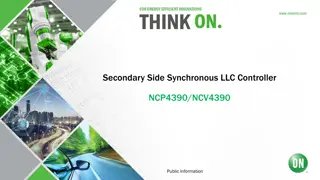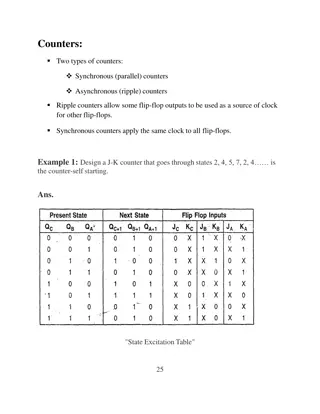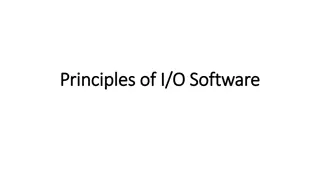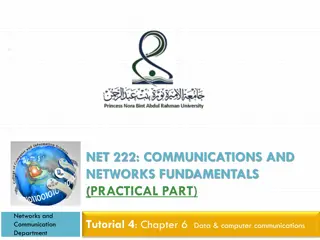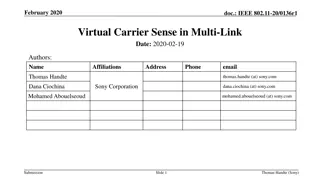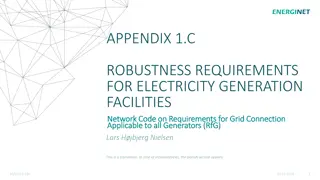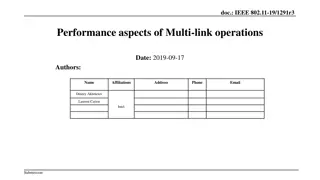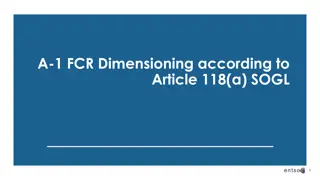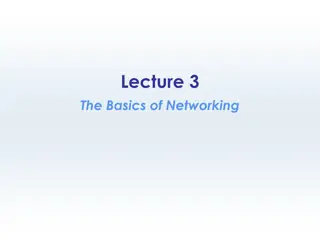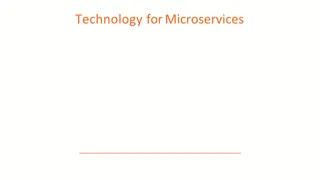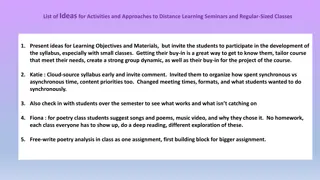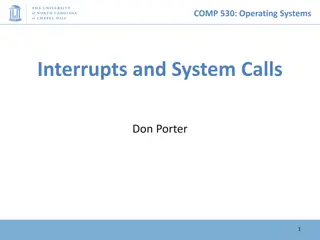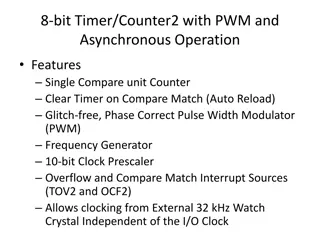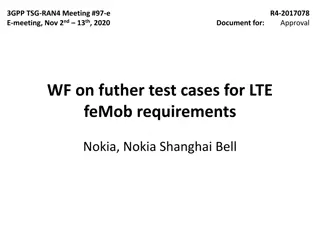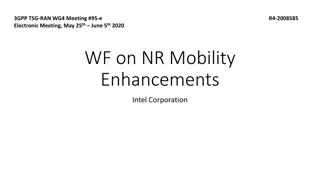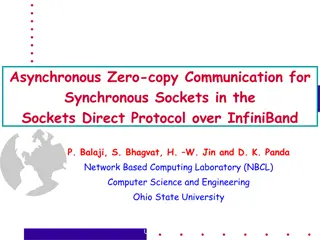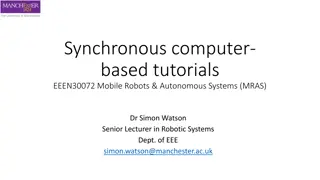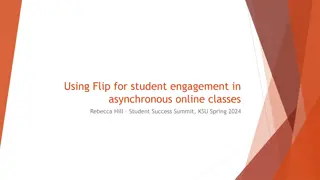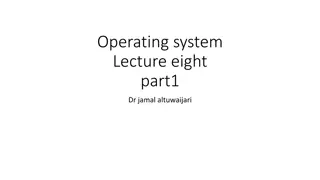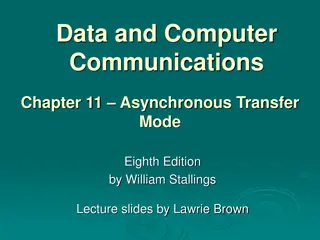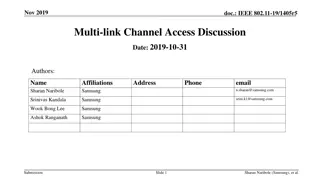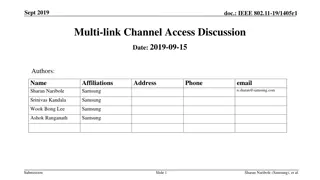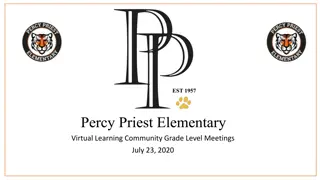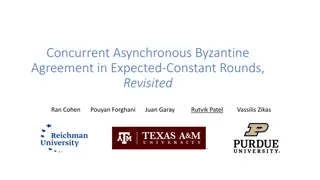Robust Real-time Multi-vehicle Collaboration on Asynchronous Sensors
A robust and real-time multi-vehicle collaboration system for asynchronous sensor data, addressing the synchronization problem and inaccurate blind spot estimation. The system leverages prediction algorithms for synchronization and enables on-demand data sharing for accurate blind spot estimation.
11 views • 12 slides
Overview of Distributed Systems: Characteristics, Classification, Computation, Communication, and Fault Models
Characterizing Distributed Systems: Multiple autonomous computers with CPUs, memory, storage, and I/O paths, interconnected geographically, shared state, global invariants. Classifying Distributed Systems: Based on synchrony, communication medium, fault models like crash and Byzantine failures. Comp
9 views • 126 slides
Understanding Binary Counters and Types of Counters
Binary counters are registers used to count clock pulses, while binary counters follow the binary number sequence. There are two types of counters: serial/asynchronous counters and parallel/synchronous counters. Serial counters change output flip-flop to next flip-flop, requiring minimal hardware bu
11 views • 21 slides
Understanding Sequential Logic in NUS CS2100 Lecture #19
Explore the concepts of sequential logic in Lecture #19 by Aaron Tan at NUS, covering memory elements, latches, flip-flops, asynchronous inputs, synchronous sequential circuits, and different types of sequential circuits. Delve into the distinction between combinatorial and sequential circuits, memo
2 views • 26 slides
Design of Asynchronous State Machine Steps and Example Circuit
Steps for designing an asynchronous state machine including primitive state diagram, flow table reduction, merging, adjacency sets, and flow table assignments. An example circuit design with S-R flip-flops for a specific sequential logic requirement is demonstrated.
0 views • 7 slides
NCP4390/NCV4390 Secondary Side Synchronous LLC Controller
The NCP4390/NCV4390 is an advanced secondary side controller for LLC resonant converters with Synchronous Rectification (SR). It features current mode control based on charge control, dual-edge adaptive dead time control, and is an upgrade of FAN7688. The controller offers benefits like excellent tr
1 views • 6 slides
Understanding Synchronous and Asynchronous Counters in Digital Electronics
Explore the concepts of synchronous (parallel) and asynchronous (ripple) counters in digital electronics, where ripple counters enable clock sharing among flip-flops and synchronous counters apply the same clock to all. Learn to design J-K and up-down counters using flip-flops with examples and stat
1 views • 4 slides
Principles and Goals of I/O Software Explained
This informative content discusses the principles and goals of I/O software, including device independence, uniform naming, error handling, synchronous vs asynchronous operations, and buffering. It emphasizes the importance of writing programs that can access any I/O device without specifying the de
5 views • 20 slides
Exploring Probability Through Equally Likely Games in Remote Learning
Engage students in investigating statistical outcomes of games to enhance their understanding of probability concepts. The task involves learning and playing two games, analyzing data to make predictions and calculate probabilities. Teachers can utilize remote learning strategies, such as asynchrono
6 views • 29 slides
Remote K-8 School: Providing Equitable & Individualized Learning Environment
Welcome to Remote K-8 School where our goal is to develop confident, responsible students who strive to reach their full potential. Principal Chris Wyland & Assistant Principal Princess Shepard lead our team. Good candidates excel at independent learning and managing their time. Our school day runs
0 views • 10 slides
Distributed Algorithms for Leader Election in Anonymous Systems
Distributed algorithms play a crucial role in leader election within anonymous systems where nodes lack unique identifiers. The content discusses the challenges and impossibility results of deterministic leader election in such systems. It explains synchronous and asynchronous distributed algorithms
2 views • 11 slides
Guide to Dealing with Asynchronous World in Game Development
Dive into the world of dealing with asynchronous tasks in game development, exploring topics like shifting responsibilities, queuing strategies, and basic hints for efficient handling. Understand the complexities involved in managing CPU and GPU interactions, optimizing performance, and structuring
0 views • 27 slides
Fundamentals of Data and Computer Communications Explained
In this tutorial, we delve into Chapter 6 of data and computer communications, focusing on transmission overhead calculations, asynchronous and synchronous communication comparisons, CRC computation, and character transmission requirements. Learn about start bits, stop bits, control bits, parity bit
1 views • 12 slides
Virtual Carrier Sense in Asynchronous Multi-Link Networks
Exploring the implementation of virtual carrier sense in asynchronous multi-link networks based on IEEE 802.11 standards. The presentation discusses the benefits of using NAV (Network Allocation Vector) in asynchronous multi-link setups to avoid hidden node issues, improve throughput, and latency. I
0 views • 16 slides
Virtual Carrier Sense in Multi-Link Networks
This document discusses the implementation and advantages of virtual carrier sense in multi-link networks under the IEEE 802.11 standard. It explores the operation of multi-link setups, asynchronous communication benefits, and the necessity of multiple contention channels. The concept of NAV (Networ
2 views • 11 slides
Understanding Different Types of Sound in Media Production
Explore the various types of sound in media products, including diegetic, non-diegetic, offscreen sound, sonic flashback, synchronous sound, asynchronous sound, ambient sound, contrapuntal sound, sound effects, and pleonastic sound. Learn how each type enhances storytelling and creates immersive exp
0 views • 14 slides
Robustness Requirements for Electricity Generation Facilities
The document outlines robustness requirements for electricity generation facilities, covering fault-ride-through properties, clear time and voltage parameters for different types of generation facilities connected to both the distribution grid and transmission grid. Specific requirements for synchro
0 views • 8 slides
Performance Aspects of Multi-link Operations in IEEE 802.11-19/1291r0
This document explores the performance aspects, benefits, and assumptions of multi-link operations in IEEE 802.11-19/1291r0. It discusses the motivation for multi-link operation in new wireless devices, potential throughput gains, classification of multi-link capabilities, and operation modes. The s
0 views • 30 slides
Performance Aspects of Multi-link Operations in IEEE 802.11-19/1291r3
This document discusses the motivation, assumptions, and classifications related to multi-link operations in IEEE 802.11-19/1291r3 standard. It explores the benefits of multi-link capabilities in new wireless devices, such as improved throughput, reduced latency, and potential for link aggregation.
0 views • 18 slides
FCR Dimensioning Rules Proposal for Synchronous Area Operational Agreements
Article 118 of the Synchronous Operational Agreements introduces rules for the dimensioning of Frequency Containment Reserve (FCR). The proposal requires TSOs to jointly develop guidelines for FCR dimensioning, including annual reserve capacity determination and initial obligations. Specific criteri
0 views • 16 slides
Basics of Networking Communication and Internet Structure
The content covers the basics of networking communication, including synchronous and asynchronous communication, broadcast, multicast, and point-to-point communication. It also discusses internet properties, client/server structure, and interactions in client/server relationships. The visuals provid
0 views • 39 slides
Clear Approach to Cancellation of Asynchronous Operations
This resource discusses the concept of cancellation primitives, providing a clear and consistent approach to cancelling asynchronous operations. It emphasizes separating the source and sink, enabling synchronous and asynchronous observation of cancellation requests. The goal is to facilitate composa
0 views • 17 slides
Understanding Communication Patterns in Microservices Technology
Exploring synchronous and asynchronous communication in microservices, emphasizing the client-to-service communication models, the use of HTTP verbs, and considerations for network performance and security. The content delves into the intricacies of request-response communication, remote procedure c
0 views • 27 slides
Creative Approaches to Engaging Students in Distance Learning Seminars
Encourage student participation in syllabus development, utilize diverse activities like poetry analysis and genre exploration, implement synchronous/asynchronous balance, and leverage tools like MEMES, audio blogs, and PollEverywhere for interactive and dynamic learning experiences.
0 views • 8 slides
Understanding Operating System Interrupts and System Calls
Explore the fundamentals of operating system interrupts and system calls in COMP.530. Learn about synchronous and asynchronous interrupts, control flow handling, and the hardware tools available for irregular control flow. Delve into the key building blocks of operating systems such as context switc
0 views • 30 slides
8-bit Timer/Counter2 with PWM and Asynchronous Operation
The 8-bit Timer/Counter2 with PWM and Asynchronous Operation features single compare unit, glitch-free operation, phase-correct PWM, frequency generator, clock prescaler, interrupt sources, and external clocking options. It includes registers for control, counter, output compare, asynchronous status
0 views • 14 slides
Challenges and Innovations in CXL 3.0 Dynamic Capacity Devices
Exploring the intricacies of CXL 3.0 Dynamic Capacity Devices presented at the LPC CXL micro conference 2023, focusing on asynchronous memory operations, partial extents, interleaving flow challenges, and memory sharing. The discussion delves into the dynamic capacity feature allowing memory changes
0 views • 17 slides
LTE feMob RAN4 Meeting Test Cases Approval Document
Approval document for LTE feMob test cases was discussed in the 3GPP TSG-RAN4 Meeting #97-e. Nokia, Nokia Shanghai Bell, Qualcomm, and Huawei are responsible for various test cases related to intra-band, inter-frequency synchronous, and asynchronous handovers. The meeting also outlined new inter-fre
0 views • 4 slides
3GPP TSG-RAN-WG4 Meeting #95-e - Mobility Enhancements Overview
The document outlines agreements from the 3GPP TSG-RAN-WG4 Meeting #95-e on NR Mobility Enhancements. It covers background agreements, DAPS handover agreements, interruption requirements, and definitions for asynchronous and synchronous DAPS handover scenarios.
0 views • 6 slides
Asynchronous Zero-copy Communication in Sockets Direct Protocol over InfiniBand
This study explores the implementation of Asynchronous Zero-copy Communication for Synchronous Sockets in the Sockets Direct Protocol over InfiniBand. It discusses InfiniBand's high performance, low latency, and advanced features, as well as the Sockets Direct Protocol as a high-performance alternat
0 views • 36 slides
Overview of EEEN30072 Mobile Robots & Autonomous Systems Course by Dr. Simon Watson
Providing a comprehensive introduction to mobile robots and autonomous systems, the EEEN30072 course led by Dr. Simon Watson is aimed at 3rd-year students, offering a mix of asynchronous materials and synchronous sessions. The course structure includes interactive synchronous exercises, group discus
0 views • 8 slides
Enhancing Student Engagement with Flip in Asynchronous Online Classes
Explore the use of Flip for student engagement in asynchronous online classes through real student feedback and examples. Learn how Flip encourages interaction and collaboration, making online learning more dynamic and engaging for students. Discover various ways to use Flip for assignments, discuss
0 views • 15 slides
Understanding Asynchronous and Concurrent Processes in Operating Systems
Exploring the concepts of asynchronous and concurrent processes in operating systems, this lecture covers how processes can function independently or require occasional synchronization. It also delves into parallel processing complexities, control structures for indicating parallelism, precedence gr
0 views • 14 slides
Understanding Sequence Diagrams in Software Development
Sequence diagrams depict the sequence of actions in a system, capturing the invocation of methods in objects. They are a valuable tool for representing dynamic system behavior. Message arrows in sequence diagrams indicate communications between objects, illustrating synchronous and asynchronous mess
0 views • 21 slides
Understanding Asynchronous Transfer Mode (ATM) in Data and Computer Communications
Asynchronous Transfer Mode (ATM) is a packet transfer technology that supports multiple logical connections over a single physical interface. It uses fixed-sized packets called cells for data transfer. ATM bears similarities to packet switching and offers streamlined packet transfer with minimal err
0 views • 46 slides
Evolution of Communication: From In-Person Cons to Modern Chat Platforms
Delve into the historical perspective of communication methods and witness the shift from in-person synchronous conversations to the asynchronous and versatile chat platforms of today. Explore the pros and cons of various communication mediums along the timeline, highlighting the significance of cur
0 views • 19 slides
IEEE 802.11-19/1405r5 Multi-Link Channel Access Discussion
The document discusses multi-link channel access in IEEE 802.11-19/1405r5, focusing on aspects like transmission of frames over multiple links, minimizing negotiation overhead for fast link switching, and per-link backoff procedures. It covers asynchronous and synchronous operations, STR constraints
0 views • 17 slides
IEEE 802.11-19/1405r1 Multi-link Channel Access Discussion
Introduction to multi-link channel access in IEEE 802.11-19/1405r1 focusing on asynchronous and synchronous operations, per-link backoff procedures, simultaneous transmit and receive operations, and the challenges posed by STR constraints at the access points. The document discusses the capabilities
0 views • 18 slides
Virtual Learning Community Grade Level Meetings Summary
Virtual Learning Community Grade Level Meetings for July 23, 2020 focus on the necessary technology requirements, synchronous and asynchronous learning opportunities, attendance guidelines, grading, and feedback details. Students are required to have devices with internet access and must engage in b
0 views • 20 slides
Optimally Resilient Asynchronous Multi-Valued Byzantine Agreement
Exploring the challenges and solutions in achieving optimally resilient asynchronous multi-valued Byzantine agreement protocols. This work presents a novel construction meeting key requirements and delves into round-preserving parallel composition of agreements, shedding light on probabilistic termi
0 views • 19 slides
